Planning performance statistics 2020/2021: quarterly (April 2020 to September 2020)
This report presents summary statistics on planning application decision-making timescales for April to September 2020, as well as historic data back to 2016/17. It is based on data collected from Local and Planning Authorities as part of the Planning Performance Framework (introduced in 2012).
This document is part of a collection
2. Local Developments
Local developments include applications for changes to individual houses and smaller developments for new housing as well as applications covering areas of development such as minerals, business and industry, waste management, electricity generation, freshwater fish farming, marine finfish farming, marine shellfish farming, telecommunications, Approval of Matters Specified in Conditions (AMSCs) and other developments.
This section presents quarterly information on average timescales across all local developments, along with separate figures for the key categories of householder, housing, business and industry and other developments. Information on other local development categories is reported on an annual rather than quarterly basis.
Some local authorities use processing agreements where the developer and the local authority agree on timescales for decisions. When an application is subject to a processing agreement it is not included in average decision time calculations.
Legacy cases validated before 3rd August 2009 are not included in the figures but are reported separately in Section 10. Figures for all applications including legacy cases were reported up to and including 2016/17 and are available in previous publications.
The number of applications and average decision times have been impacted on in the first two quarters of 2020/21 by restrictions due to the COVID-19 Pandemic. Further information about the impacts is available in Section 1.2.
2.1. All Local Developments
There were 9,619 decisions for local development applications not subject to processing agreements in the first six months of 2020/21, 3,271 (25%) fewer than in the same period in 2019/20. The average decision time was 10.0 weeks, one week slower than the 9.0 weeks for the same period in 2019/20. The percentage of decisions made in less than two months was 66.1%, a drop of 7.6 percentage points compared to the first six months of 2019/20.
In addition a number of applications were decided that were subject to processing agreements, these applications are not included in average time calculations. In quarter one of 2020/21 there were 616 local development applications with processing agreements, 78.9% of these applications met agreed timescales that had been set between developers and local authorities. In quarter two there were 667, 69.1% meeting the agreed timescales. Applications with processing agreements accounted for 11.9% of all Local Developments decisions made in quarter one and 11.7% in quarter two, an increase of almost five percentage points for each quarter compared to the same period in 2019/20. A number of authorities reported an increased use of processing agreements as part of measures to manage the impact of COVID-19 restrictions and delays.
There were also two local pre 3rd August 2009 legacy case concluded. Further details about legacy cases are in Section 10.
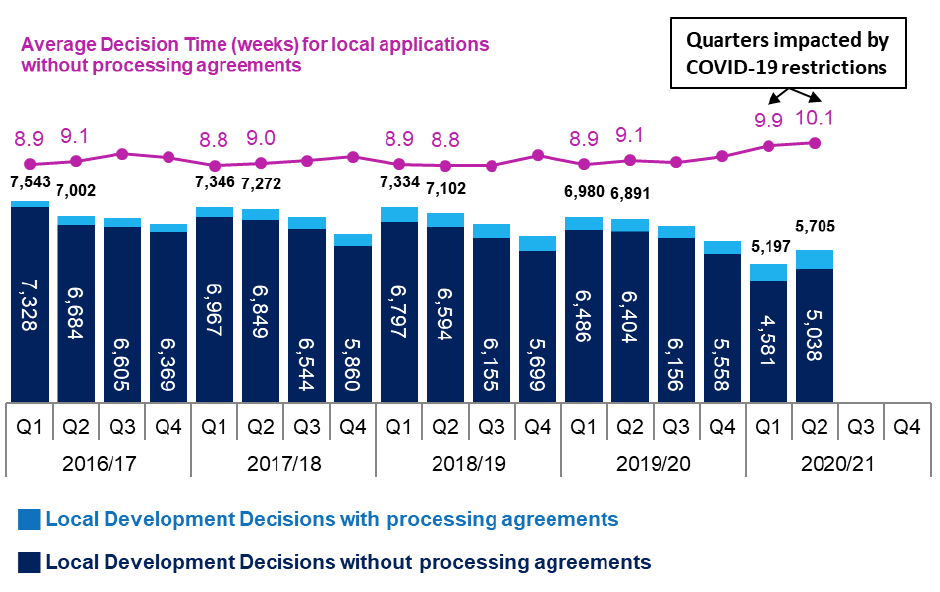
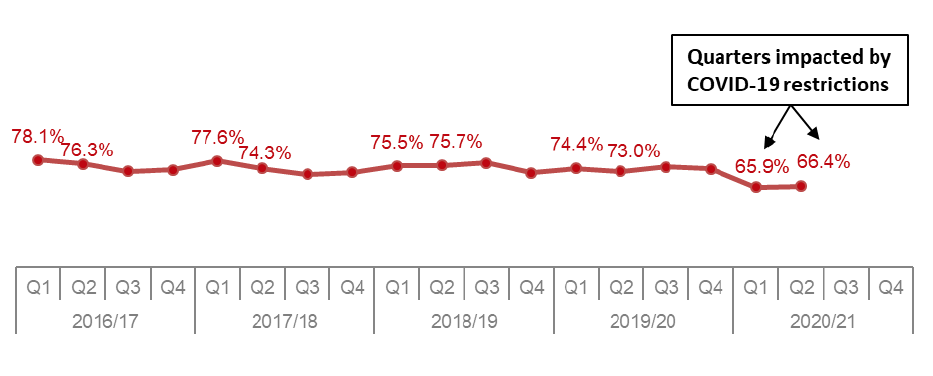
2.2. Local (Non Householder) Developments
This can include applications for smaller developments for new housing as well as applications covering areas of development such as minerals, business and industry, waste management, electricity generation, freshwater fish farming, marine finfish and shellfish farming, telecommunications, Approval of Matters Specified in Conditions (AMSCs) and other developments.
There were 4,604 local non-householder developments not subject to processing agreements decided in the first six months of 2020/21, 1,742 (27%) fewer than the same period in the previous year. The average decision time was 12.1 weeks, more than a week slower than the 10.8 weeks for the same period in the previous year. The percentage of decisions made in less than two months was 56.7%, down from 62.9% for the corresponding six month period in the previous year.
In addition a number of applications were concluded that were subject to processing agreements, these are not included in average time calculations. In quarter one of 2020/21 there were 379 local non householder development applications with processing agreements, 74.1% of these applications met agreed timescales that had been set between developers and local authorities. In quarter two there were 412, 69.7% meeting the agreed timescales.
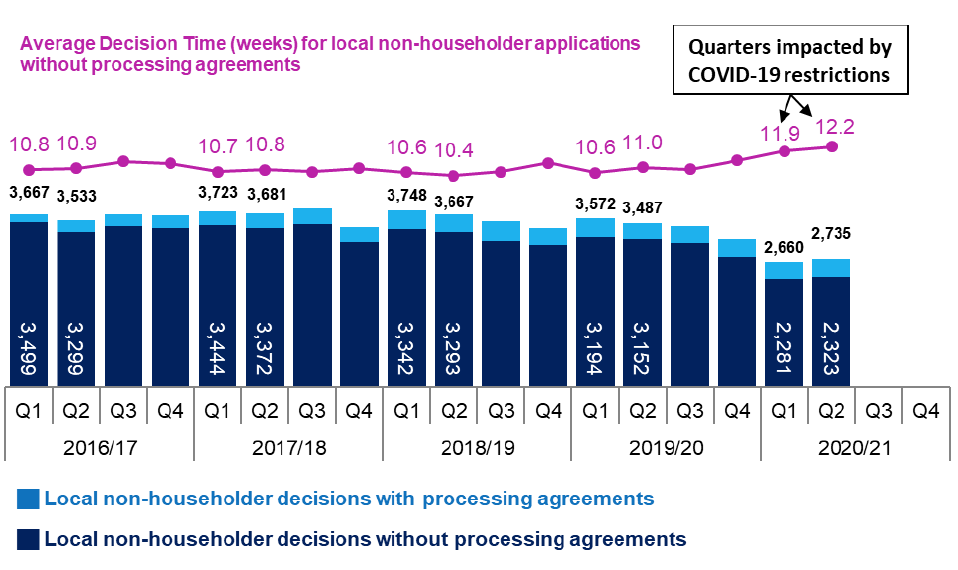
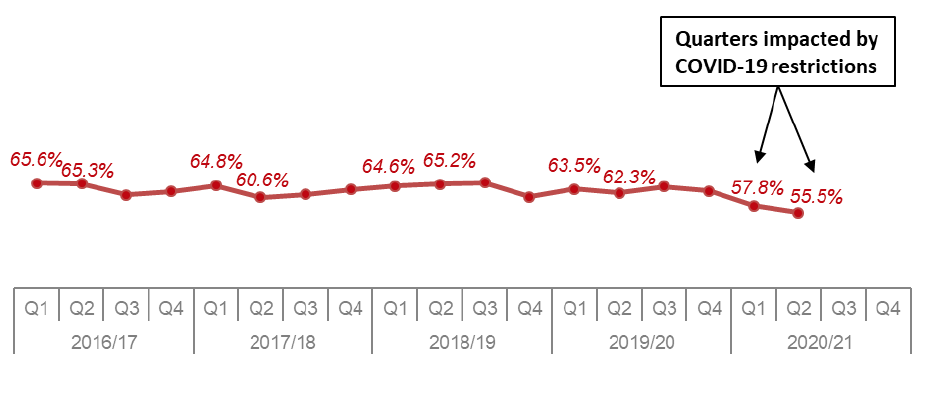
2.3. Householder Developments
These include all applications for development in the curtilage of a residential property which are not change of use, for example: extensions, alterations to garages, swimming pools, walls, fences, driveways or porches.
There were 5,015 householder developments not subject to processing agreements decided during the first six months of 2020/21, 1,529 (23%) fewer than in the same period in the previous year. The average decision time was 8.1 weeks, just under a week slower than the 7.3 weeks for the same period in 2019/20. The percentage of decisions made in less than two months was 74.8%, down from 84.2% for the corresponding six month period in the previous year.
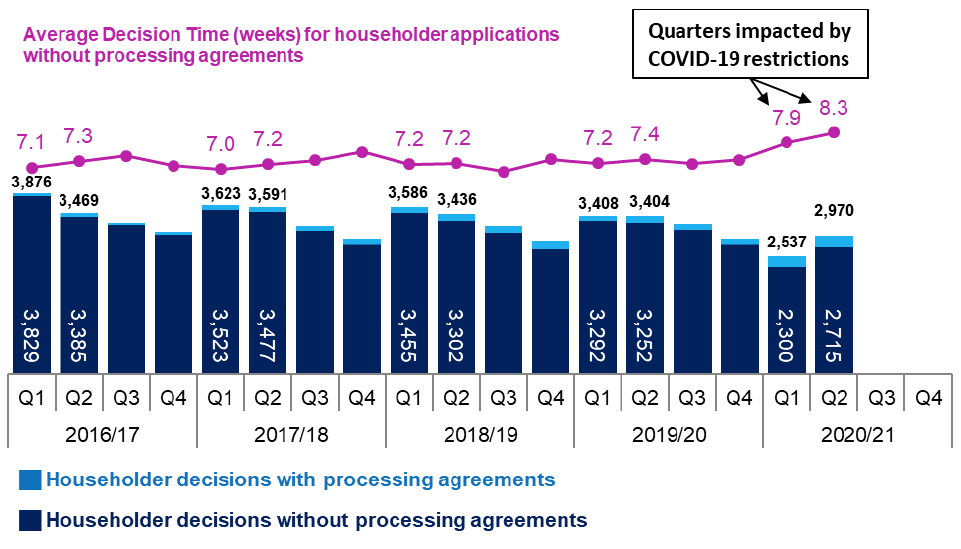
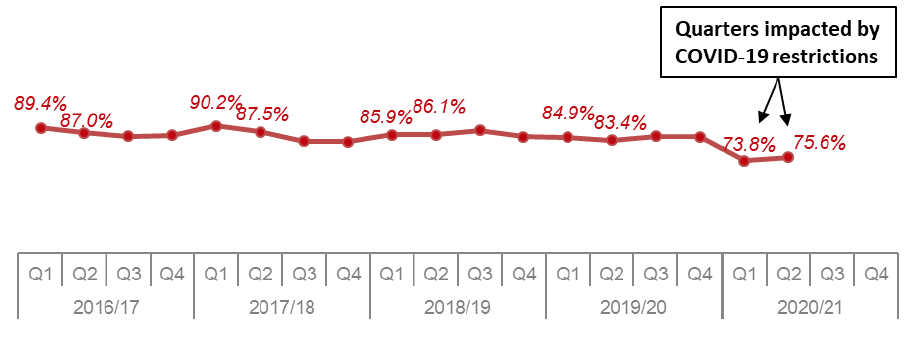
In addition a number of applications were concluded that were subject to processing agreements, these are not included in average time calculations. In quarter one of 2020/21 there were 237 householder applications with processing agreements, 86.5% met agreed timescales set between developers and local authorities. In quarter two there were 255, 68.2% meeting agreed timescales.
2.4. Local Housing Developments
Local housing developments are those that have less than 50 dwellings and a site area that is less than 2 hectares.
There were 1,650 local housing developments not subject to processing agreements decided during the first six months of 2020/21, 543 (25%) fewer than the same period in the previous year. The average decision time was 13.5 weeks, more than a week slower than the 12.3 weeks for the same period in the previous year. The percentage of decisions made in less than two months was 51.0%, down from 54.2% for the first six months of 2019/20.
In addition a number of applications were concluded that were subject to processing agreements, these are not included in average time calculations. In quarter one of 2020/21 there were 149 local housing applications with processing agreements, 73.8% of these met agreed timescales set between developers and local authorities. In quarter two there were 175, 72.0% meeting the agreed timescales.
There were also two local housing pre 3rd August 2009 legacy cases concluded. Further details about legacy cases are in Section 10.
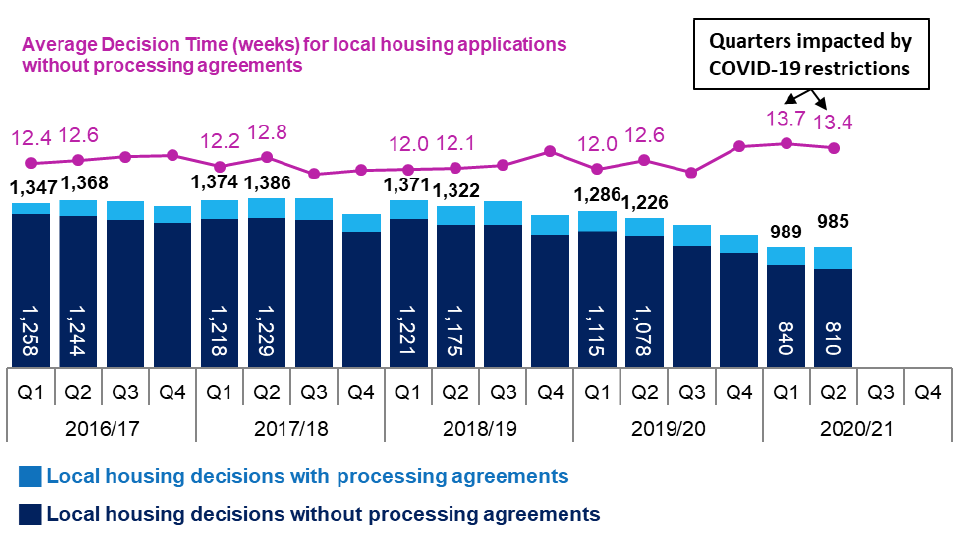
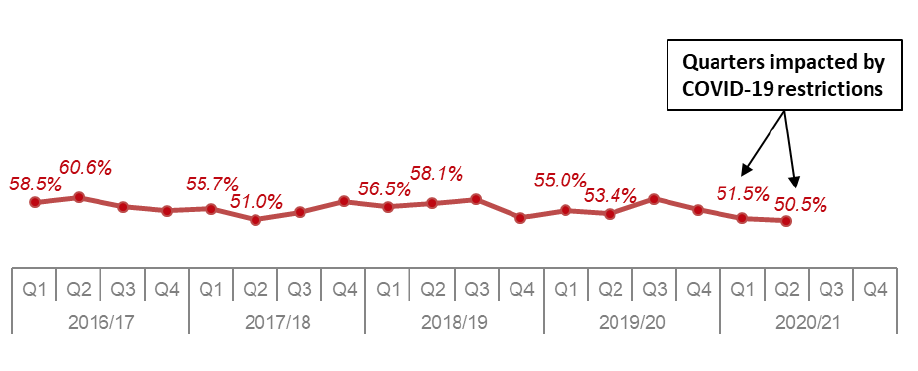
2.5. Local Business and Industry Developments
Business and industry developments include construction of a building or structure for any of the following: use as an office, for research and development of products or processes, for any industrial process or for use for storage or as a distribution centre.
To be classed as local gross floor space as a result of the development must not exceed 10,000 square metres and the site area must be 2 hectares or less.
There were 583 local business and industry developments not subject to processing agreements decided during the first six months of 2020/21, 58 (9%) fewer than the same period in the previous year. The average decision time was 11.1 weeks, a week slower than the 10.1 weeks for the for the first six months of 2019/20.
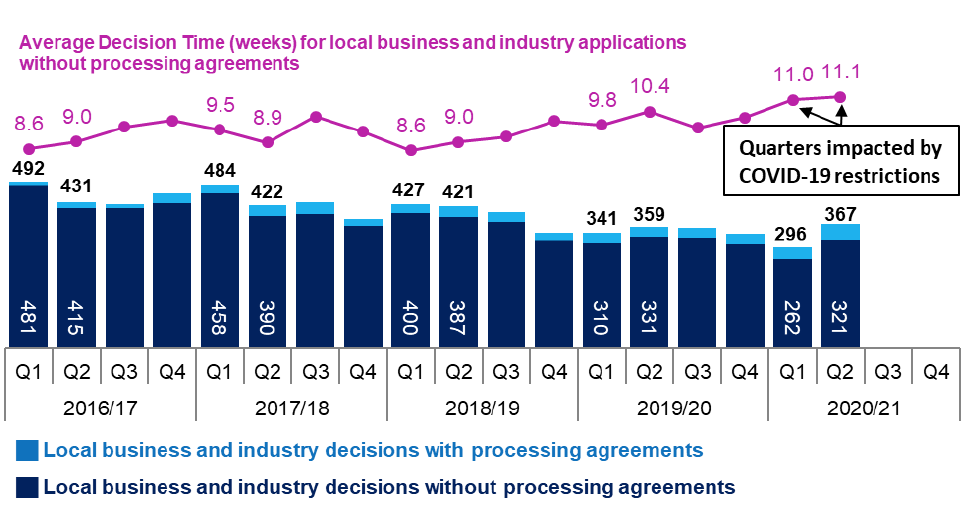
The percentage of decisions made in less than two months was 62.1%, a drop of seven percentage points from 69.1% for the corresponding six month period in the previous year.
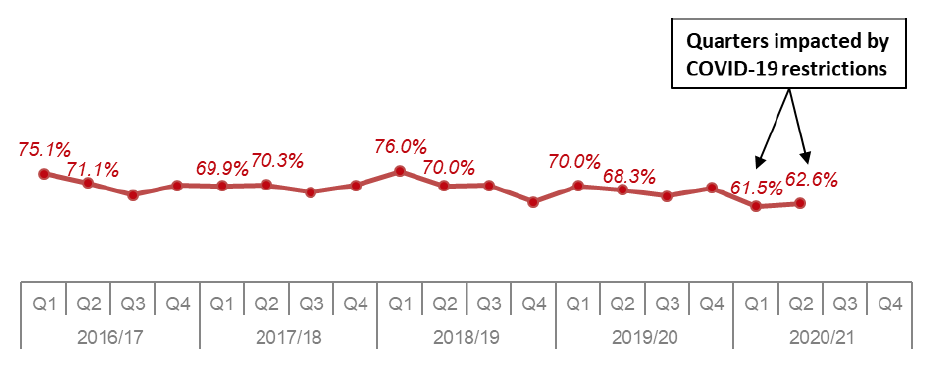
In addition a number of applications were concluded that were subject to processing agreements, these are not included in average time calculations. In quarter one of 2020/21 there were 34 local business and industry applications with processing agreements, 61.8% of these met agreed timescales set between developers and local authorities. In quarter two there were 46, 65.2% meeting agreed timescales.
2.6. Local Other Developments
Other developments are developments not falling wholly within any other single class. They include but are not limited to retail, leisure and entertainment, education, healthcare, community facilities, transport interchanges, water and drainage developments and projects. This class also covers mixed use projects.
Local other developments are those where the gross floor space of any building, structure or erection as a result of such development is less than 5,000 square metres and the area of the site is less than 2 hectares.
There were 2,079 local other developments not subject to processing agreements decided during the first six months of 2020/21, 1,051 (34%) fewer than in the same period in the previous year. The average decision time was 10.7 weeks, one week slower than the 9.7 weeks for the first six months of 2019/20. The percentage of decisions made in less than two months was 60.5%, down more than eight percentage points from 68.8% for the same six month period in the previous year.
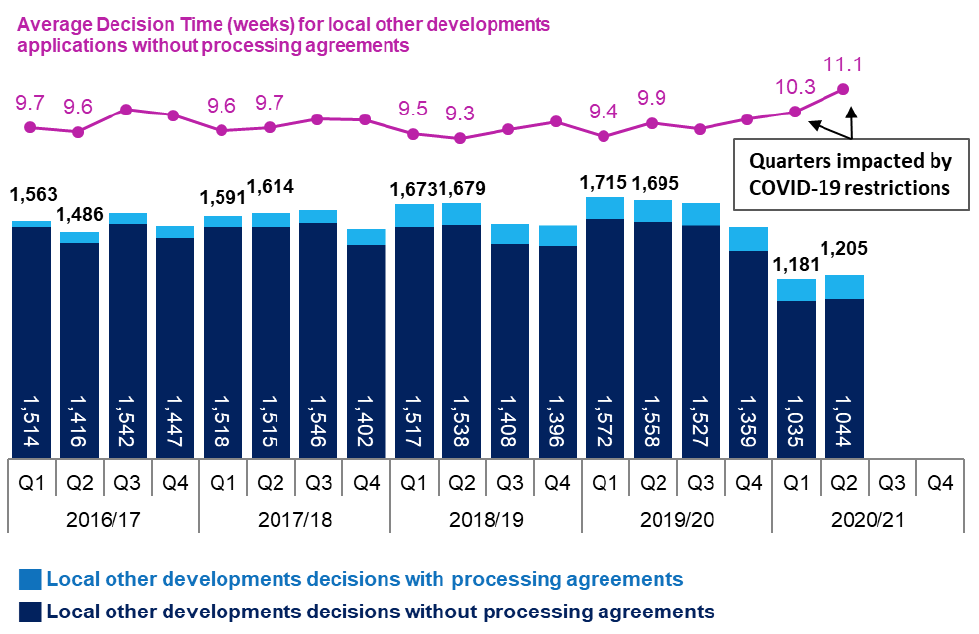
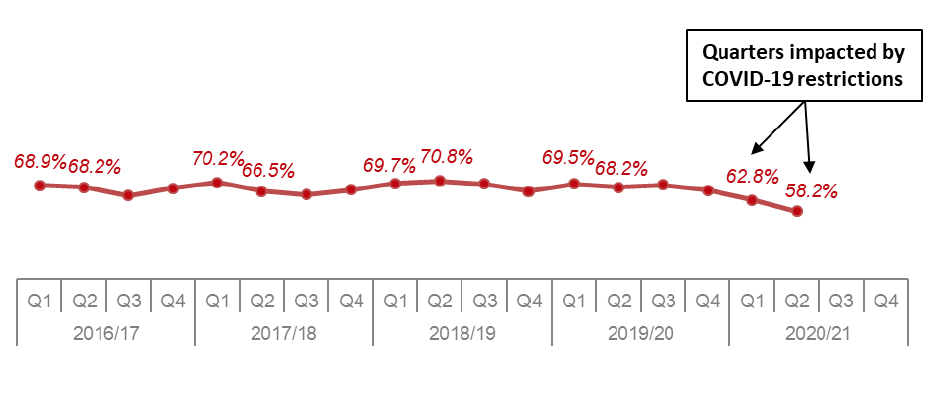
In addition a number of applications were concluded that were subject to processing agreements, these are not included in average time calculations. In quarter one of 2020/21 there were 146 local other developments applications with processing agreements, 81.5% of these met agreed timescales that had been set between developers and local authorities. In quarter two there were 161, 68.3% meeting agreed timescales.
Contact
Email: planstats@gov.scot
There is a problem
Thanks for your feedback